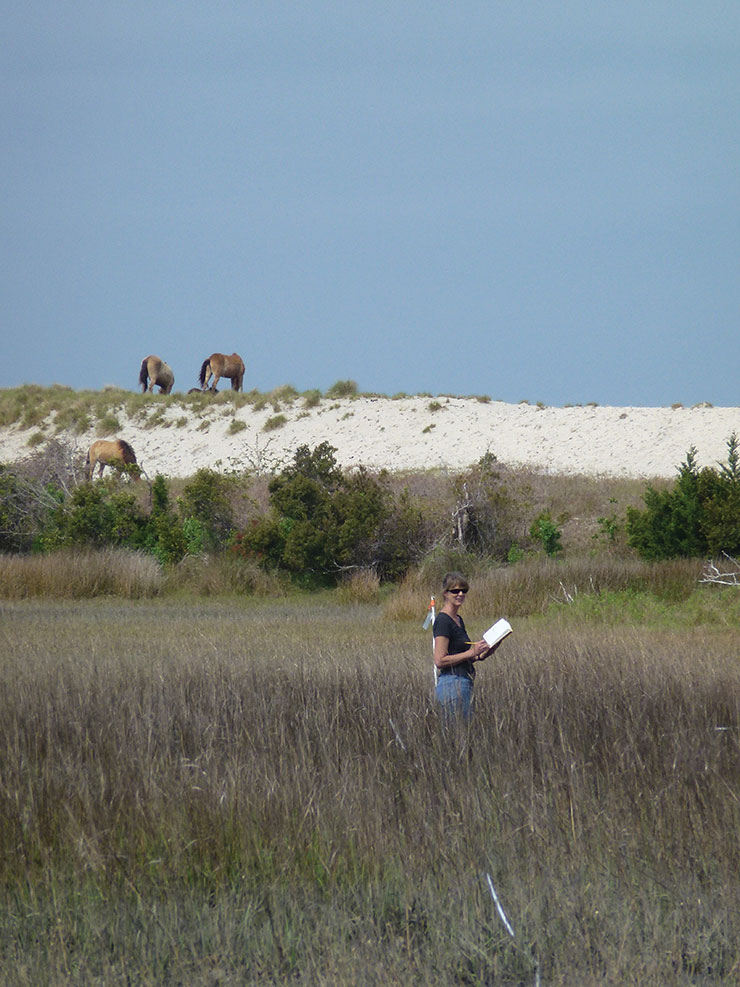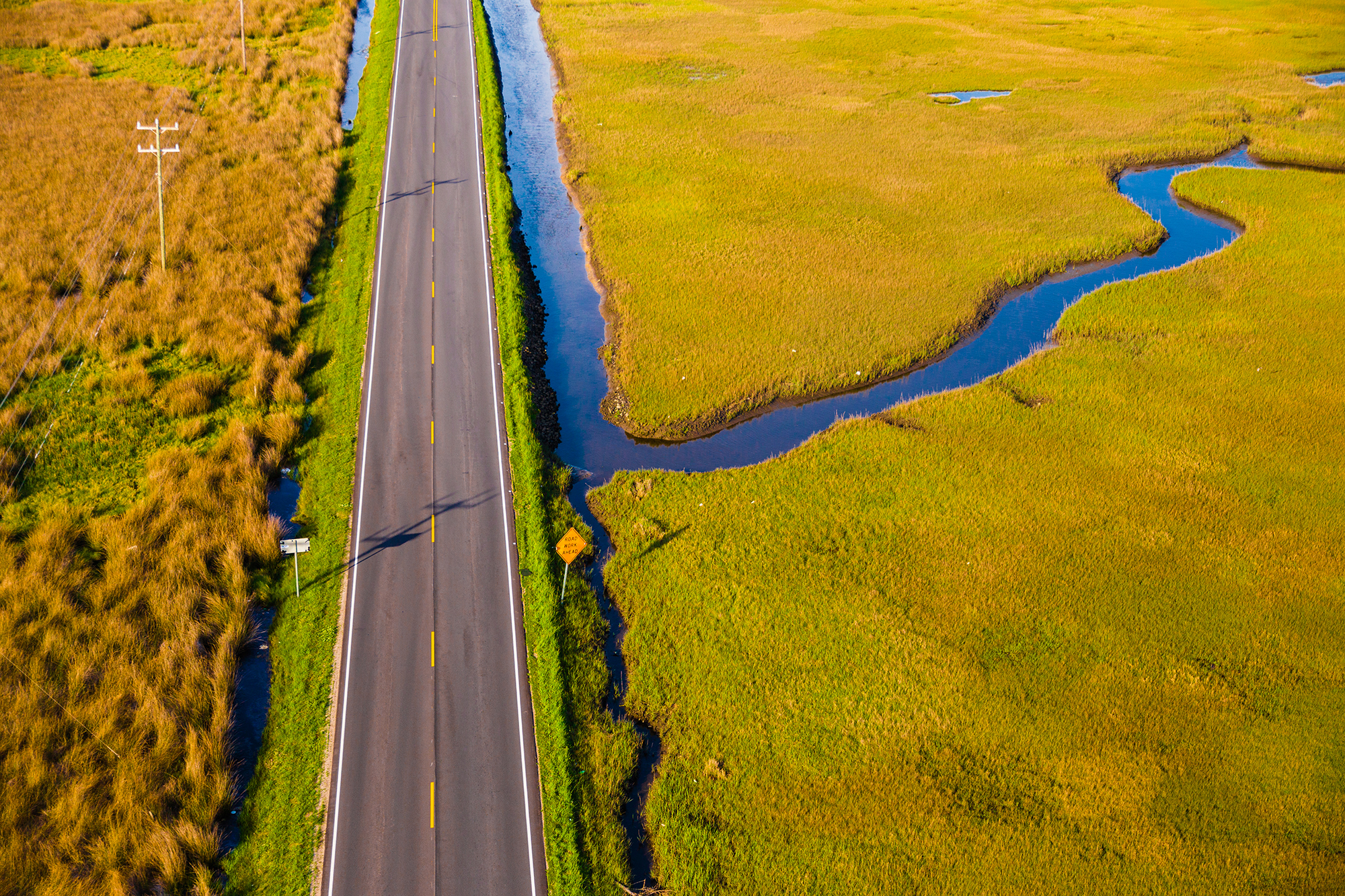SEA SCIENCE: Traversing Untrodden Ground

The mud sucks at her boots as Teri O’Meara enters the marsh on Carrot Island. But the University of North Carolina at Chapel Hill graduate student doesn’t turn back. Instead she ventures in deeper to compare bacterial and fungal activity in different areas on the island.
She is studying fungi’s role in denitrification in the marsh, where nitrogen is removed from the soil and released to the air as a gas.
O’Meara is accustomed to traversing the soft mud that is likely to sink a less experienced person.
Not only has she adapted a technique for skating over the surface without getting stuck, but also she works out faithfully to keep her legs strong.
“I never skimp on the lunges,” O’Meara says.
Pry into an old rotten log and you’ll likely see tangled white strands of fungi. Some of these almost-invisible organisms are responsible for mushrooms that sprout up after a rain. These organisms have long been cited as a crucial part of the carbon cycle, which breaks down organic material into carbon dioxide.
Now, O’Meara’s research being conducted in North Carolina is showing that fungi also can be important components of the nitrogen cycle in marshes.
O’Meara is advised by coastal ecologist Michael Piehler at the UNC Institute of Marine Sciences in Morehead City and the UNC Coastal Studies Institute in Dare County. North Carolina Sea Grant and the N.C. Coastal Reserve awarded her a Coastal Research Fellowship to study how denitrification occurs in marshes and the bordering maritime forest. The grants are available to graduate students conducting research within one or more of the 10 sites within the N.C. Coastal Reserve, which is part of the National Estuarine Research Reserve System.
“Teri’s study will be a great comparison to the previous findings in other soil ecosytems,” says Bongkeun Song, microbial ecologist at Virginia Institute of Marine Science and a former Sea Grant-funded researcher who is following O’Meara’s work. “The study may reveal that fungi are important microbial removers of excess nitrogen in coastal ecosystems.”
NITROGEN: GOOD AND BAD
Nitrogen is essential for plant growth, but too much of it can encourage harmful algal blooms that may cause fish kills. Fortunately, it can be removed from the environment by denitrification. During denitrification, microbes, such as bacteria, convert the nitrate form of nitrogen to atmospheric nitrogen.
Marshes are rich environments for organisms that soak up excess nutrients running off from lawns and farms. Piehler calls marshes — and the organisms that they support — “a critical line of defense for keeping the coastal waters in balance.” In the marsh, the nitrogen-containing nutrients are absorbed by the marsh plants and also denitrified, a microbial process that further mitigates the negative effects of too much nitrogen in the environment.

Until recently, scientists credited only bacteria for denitrification. In the course of her literature research, O’Meara found studies looking at fungal denitrification in agricultural systems, fresh water and in the deep ocean. But no one seemed to be looking at fungi in the marshes — an important location for nitrogen cycling.
O’Meara had just completed a study that found that denitrification occurred behind bulkheaded marshes as well as in marshes without bulkheads. But, she wondered about the cause of the process, whether it could be fungal as well.
Piehler’s lab is equipped to study denitrification. Sea Grant has funded his research to study the role that marshes, including the sediments around oyster reefs, play in removing excess nitrogen.
He recalls his own skepticism when O’Meara first proposed to go into the marsh to find out if fungi were responsible for nitrogen cycling there. Only a few studies have looked at nitrogen processing by fungi, and none were conducted in marsh environments.
Piehler advised her to choose a study area that was more likely to be relevant to nitrogen processing. As it turns out, he says, “She was absolutely right.” Now, as he discusses O’Meara’s work, he’s finding that other researchers are “very interested in the distinction between fungal and bacterial denitrification.”
SCENIC RESEARCH
O’Meara is comparing two sites. One is on Carrot Island, located near Beaufort in the Rachel Carson component of the NCNERR. The other is the Currituck Banks Reserve, also part of the reserve system, on a barrier island near Corolla.
Carrot Island is not far from the research lab at IMS. O’Meara can reach it quickly in a short paddling trip from Beaufort.
Feral horses roam the island, which receives dredge spoil from nearby Taylor’s Creek. It also is host to a maritime shrub thicket that consists of shrubs, small trees and vines. A salt marsh dominates at lower elevations.
Currituck Banks, on the other hand, is a four-hour drive, at the northern end of N.C. 12. It borders Currituck Sound, which is nearly fresh water. It is host to a mature maritime deciduous forest and a marsh and also, feral horses.
Fortunately, it is more easily accessed from the lab at the UNC Coastal Studies Institute.

Both sites are pristine examples of North Carolina coastal habitat, which are peaceful, scenic places to visit. But during her trips, O’Meara doesn’t have much time to enjoy the views. Instead, she busily takes measurements and samples in her quest to document the quality of denitrification in the two marshes.
O’Meara explains that bacterially mediated nitrogen is a process that requires anoxic, or oxygen-poor, conditions combined with an oxic environment — where oxygen is present. This scenario is prevalent in tidally influenced marshes where areas are regularly inundated with sea water, then left high and dry when the tide goes out.
Tidal environments are ideal for bacteria to participate in the nitrogen cycle because it is only under anoxic conditions that the bacteria actually use the nitrate as an oxygen source, resulting in an end product of inert nitrogen gas. On the other hand, other bacteria, called nitrifiers, need oxygen to convert the ammonium form of nitrogen, found in fertilizers and animal excrement, into nitrate. Areas like the low marshes are considered hot spots for nitrogen reworking because of the cycling between oxic and anoxic conditions.
Fungi can work in drier areas containing oxygen, which are considered off-limits to the denitrifying bacteria.
GETTING TO WORK
O’Meara and Suzanne Thompson, lab manager, first went to the islands to characterize the elevations of four ecological zones: the subtidal zone, low marsh, high marsh and maritime forest.
At Rachel Carson Reserve, an elevation difference of only 50 inches separates the subtidal zone from the maritime forest. At Currituck Banks, this range is even less — 15 inches. And yet this gradual slope means all the difference in whether an area will be a marsh or a maritime forest.
O’Meara hypothesized that fungal denitrification would predominate in the high marsh and maritime forest areas, while bacteria would be more active in subtidal and low marsh zones.
However, the results showed that fungi are a significant source of denitrification in the lower elevations with tidal influence. As O’Meara explains it, subtidal zones are always inundated with water. These areas are often tidal creeks.
She distinguishes the other zones by the plant life. In the low marsh, grasses such as the tall version of Spartina grass grow. In the high marsh, she finds the plants like the short form of Spartina and Juncus grasses. The maritime forest consists of mature trees such as live oak and undergrowth including wax myrtle and Virginia creeper.
During summer 2012, O’Meara traversed back and forth between Rachel Carson Reserve, Currituck Banks and IMS many times. Sometimes alone, sometimes with a helper, she took up to 300 surface soil samples at various elevations from each site.
At the lab, she lines up hundreds of glass vials filled with the sediment samples. She treats the samples either with an antifungal or an antibiotic, supplies nitrate and measures the amount of nitrogen gas released over time. This procedure is designed to define whether the samples contain bacteria or fungi, or both, that are capable of denitrification.
O’Meara plans to strengthen her data by continuing to collect and analyze samples in the spring and summer of 2013. In any case, it is likely that her groundbreaking study will establish new ways of thinking about the organisms that flourish in — and clean up — the marshes.
John Fear, research coordinator for the NCNERR in the N.C. Division of Coastal Management, assisted O’Meara at the Currituck Banks site. “Teri’s work into the importance of fungal denitrification in our coastal marine systems will greatly increase our knowledge of this previously unconsidered nitrogen cycle process,” he says.
For more information on the N.C. Coastal Reserve, visit www.nccoastalreserve.net. To learn about the National Estuarine Research Reserve System, go to www.nerrs.noaa.gov.
Go to www.ncseagrant.org and follow the research links for details on fellowships funded by North Carolina Sea Grant and its partners.
THE NITROGEN CYCLE
Nitrogen is an element that can exist as several chemical forms. As Teri O’Meara explains, nitrogen gas is approximately 80 percent of our air.
Nitrogen compounds are the main active ingredient in lawn fertilizer as either urea or ammonia.
Without it, plants become pale and unhealthy. Urea and ammonia are known as “fixed” forms of nitrogen because the element has been combined with hydrogen. Before the early 20th century, when Fritz Haber discovered a process to convert atmospheric nitrogen into ammonia, the amount of fertilizer for crops was limited to that produced by certain nitrogen-fixing plants and the occasional lightning strike.
Now that fixed nitrogen is in unlimited supply, it can cause algal overgrowth, which is unsightly and also robs the waters of oxygen when it decays, causing fish kills.
Enter the salt marsh. It has long been known that the tidal conditions contributing to a wet, alternating with dry, environment throughout the day are conducive to bacterial denitrifiers.

Some bacteria convert the ammonia form to nitrate during drier conditions. This nitrate then provides oxygen for other bacteria during periods of inundation, when oxygen is depleted. Finally the nitrogen is released back to the atmosphere as the inert gas.
The bacterially mediated processing of nitrogen was thought to be the only contributor of nitrogen processing until a Japanese group published in 1992 that they had found fungi capable of processing fixed nitrogen under laboratory conditions.
Unlike bacteria though, the major end product is nitrous oxide, not the inert form of nitrogen gas.
“Bacterial denitrification is of higher quality than fungal denitrification because it’s creating nitrogen gas,” O’Meara says.
“In fungal denitrification the primary product is nitrous oxide, which is a potent greenhouse gas.
Fungal denitrification is good for the environment because it’s removing nitrate from the system, but it’s creating another problem by adding a harmful greenhouse gas to the atmosphere,” she adds.
This article was published in the Spring 2013 issue of Coastwatch.
For contact information and reprint requests, visit ncseagrant.ncsu.edu/coastwatch/contact/.
- Categories:


